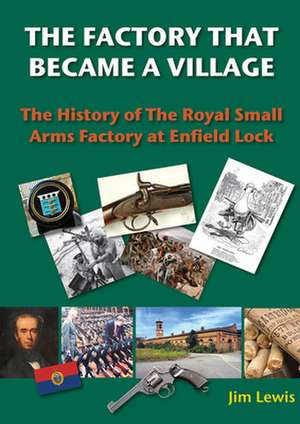The Factory that Became a Village: Lea Valley Series
Autor Jim Lewisen Limba Engleză Paperback – 22 apr 2021
At the time of writing this book the author wanted, in the two-hundredth anniversary year of the founding of the RSAF, to commemorate the contribution made to our armed forces by the former workforce which, by their skills and dedication, helped keep Britain safe during times of world instability. Also I wanted to acknowledge the contribution made to our community by the four founding fathers of the RSA Trust that has benefited so many worthwhile good causes. In a world full of increasingly depressing news it is uplifting to have the opportunity to write about a group of four local businessmen who had the vision, courage and tenacity to take on the mammoth task of rescuing a Grade II listed building that no sane entrepreneur would have contemplated taking on and turn it into a vibrant sustainable business for the benefit of the local community. The model created pays a service charge into a limited liability company, RSA IV, which in turn transfers the surplus to the not-for-profit RSA Trust which is then able to fund many community good causes.
Preț: 118.52 lei
Nou
Puncte Express: 178
Preț estimativ în valută:
22.69€ • 23.33$ • 18.82£
22.69€ • 23.33$ • 18.82£
Carte disponibilă
Livrare economică 30 ianuarie-13 februarie
Preluare comenzi: 021 569.72.76
Specificații
ISBN-13: 9780995483446
ISBN-10: 0995483442
Pagini: 172
Ilustrații: Plates, black and white
Dimensiuni: 210 x 297 x 10 mm
Greutate: 0.43 kg
Editura: Redshank Books
Seria Lea Valley Series
ISBN-10: 0995483442
Pagini: 172
Ilustrații: Plates, black and white
Dimensiuni: 210 x 297 x 10 mm
Greutate: 0.43 kg
Editura: Redshank Books
Seria Lea Valley Series
Notă biografică
Jim Lewis grew to adulthood in Cape Charles, spending his formative years on the second floor of an apartment house in the 200 block of Mason Avenue. From his second-story observation point, Jim watched the comings and goings of barges, ferries in the harbor and the arrivals and departures at the railroad station. Growing up in Cape Charles, Jim participated in all the activities that made Cape Charles the enchanting town that it was. He attended the local school for twelve years, played football for four years, was a member of the Boy Scout Troop, and did all the things that boys from Cape Charles did. He explored the Bloodfield Woods, sledded down the side of the hump, hunted ducks on Big Allegood Pond, and jumped off the white tower. To earn money during the summer, Jim worked at various jobs. He picked tomatoes on Tinkham's farm, cut grass for neighbors, stocked shelves at the local Colonial Store, and worked at Wendell's Bottling Plant. Jim drew mentors from the Cape Charles community. His school teachers: James May, the school custodian, Miss Gladys Nottingham, the local librarian, and Marshield Hunt, local scoutmaster, were people who provided life examples. Just as Mr. Lewis began the research for this Cape Charles book, he contracted Parkinson's Disease. The course of Jim's illness grew as the research for his book progressed. It took Jim 10 years to complete Cape Charles: A Railroad Town.
Descriere
Four local businessmen had the vision to rescue aGrade II listed building, the Royal Small Arms Factory, and turn it into a vibrant sustainable business for the benefit ofthe local community.
